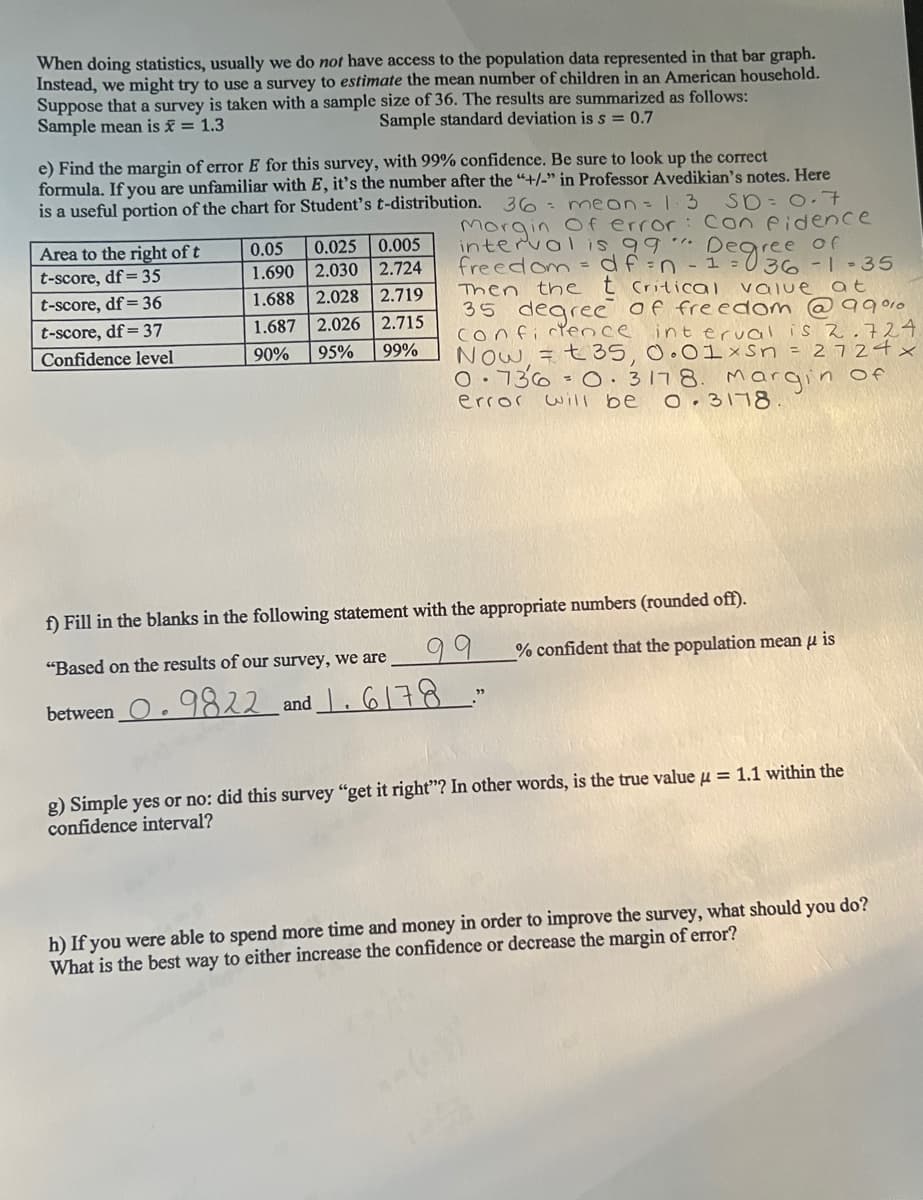Can you answer ONLY 28 G and H thanks i only need G AND H
Glencoe Algebra 1, Student Edition, 9780079039897, 0079039898, 2018
18th Edition
ISBN:9780079039897
Author:Carter
Publisher:Carter
Chapter10: Statistics
Section10.5: Comparing Sets Of Data
Problem 26PFA
Related questions
Question
Can you answer ONLY 28 G and H thanks i only need G AND H

Transcribed Image Text:When doing statistics, usually we do not have access to the population data represented in that bar graph.
Instead, we might try to use a survey to estimate the mean number of children in an American household.
Suppose that a survey is taken with a sample size of 36. The results are summarized as follows:
Sample mean is = 1.3
Sample standard deviation is s = 0.7
e) Find the margin of error E for this survey, with 99% confidence. Be sure to look up the correct
formula. If you are unfamiliar with E, it's the number after the "+/-" in Professor Avedikian's notes. Here
is a useful portion of the chart for Student's t-distribution.
36=men=13 SD 0.7
Morgin Cf error : con eidence
intervol is 99 Degree of
freedom = df=n -1 - 0 36-1-35
Then the t Critical value
35 degree of freedom @ 99 oro
conficYence int erval is 2,724.
Now = t 35, 0.01 XSn = 2 724x
O 736-0 3178.
0.025 0.005
2.030 2.724
2.028 2.719
1.687 2.026 2.715
Area to the right of t
0.05
t-score, df= 35
1.690
t-score, df= 36
1.688
at
t-score, df= 37
Confidence level
90%
95%
99%
Margin of
O. 3178.
error
will be
f) Fill in the blanks in the following statement with the appropriate numbers (rounded off).
"Based on the results of our survey, we are
99
% confident that the population mean µ is
between _O. 9822 and. 6178
g) Simple yes or no: did this survey “get it right"? In other words, is the true value µ = 1.1 within the
confidence interval?
h) If you were able to spend more time and money in order to improve the survey, what should you do?
What is the best way to either increase the confidence or decrease the margin of error?
![28. Below is a relative frequency bar chart of the number of children in American households. The
horizontal axis is the number of children (0, 1, 2, 3, or 4) and the vertical axis is the fraction of households
with that many children.
0.4
ili.
0.35
0.3
0.25
0.2
0.15
0.1
0.05
1
2
4
a) Describe the shape of this graph: is it uniform, symmetric, skewed right, or skewed left?
b) Since probabilities are just relative frequencies, we can fill in the following probability table. All you
have to do is read off the chart above. You may need a straight edge to help. One box has been filled in
for you to show the idea.
1
2
3
4
P(x)
0.24
c) Check to make sure that you’ve accounted for 100% of the data by adding up the second row – you
should get 1.00
d) Verify that the mean of this distribution is u = 1.1 The formula is µ = E[xP(x)], which means that
you should multiply each column of the table, x times P(x), then add all the results. Since you've been
given the answer, the key here is to show your work.](/v2/_next/image?url=https%3A%2F%2Fcontent.bartleby.com%2Fqna-images%2Fquestion%2F8b729196-85f9-4b0e-a4b2-d6475729d74c%2Fb68086eb-46bf-4ef9-ae50-c1b2b448fa99%2Favkrrz_processed.jpeg&w=3840&q=75)
Transcribed Image Text:28. Below is a relative frequency bar chart of the number of children in American households. The
horizontal axis is the number of children (0, 1, 2, 3, or 4) and the vertical axis is the fraction of households
with that many children.
0.4
ili.
0.35
0.3
0.25
0.2
0.15
0.1
0.05
1
2
4
a) Describe the shape of this graph: is it uniform, symmetric, skewed right, or skewed left?
b) Since probabilities are just relative frequencies, we can fill in the following probability table. All you
have to do is read off the chart above. You may need a straight edge to help. One box has been filled in
for you to show the idea.
1
2
3
4
P(x)
0.24
c) Check to make sure that you’ve accounted for 100% of the data by adding up the second row – you
should get 1.00
d) Verify that the mean of this distribution is u = 1.1 The formula is µ = E[xP(x)], which means that
you should multiply each column of the table, x times P(x), then add all the results. Since you've been
given the answer, the key here is to show your work.
Expert Solution
This question has been solved!
Explore an expertly crafted, step-by-step solution for a thorough understanding of key concepts.
Step by step
Solved in 2 steps

Recommended textbooks for you

Glencoe Algebra 1, Student Edition, 9780079039897…
Algebra
ISBN:
9780079039897
Author:
Carter
Publisher:
McGraw Hill

College Algebra (MindTap Course List)
Algebra
ISBN:
9781305652231
Author:
R. David Gustafson, Jeff Hughes
Publisher:
Cengage Learning

Algebra: Structure And Method, Book 1
Algebra
ISBN:
9780395977224
Author:
Richard G. Brown, Mary P. Dolciani, Robert H. Sorgenfrey, William L. Cole
Publisher:
McDougal Littell

Glencoe Algebra 1, Student Edition, 9780079039897…
Algebra
ISBN:
9780079039897
Author:
Carter
Publisher:
McGraw Hill

College Algebra (MindTap Course List)
Algebra
ISBN:
9781305652231
Author:
R. David Gustafson, Jeff Hughes
Publisher:
Cengage Learning

Algebra: Structure And Method, Book 1
Algebra
ISBN:
9780395977224
Author:
Richard G. Brown, Mary P. Dolciani, Robert H. Sorgenfrey, William L. Cole
Publisher:
McDougal Littell

Holt Mcdougal Larson Pre-algebra: Student Edition…
Algebra
ISBN:
9780547587776
Author:
HOLT MCDOUGAL
Publisher:
HOLT MCDOUGAL